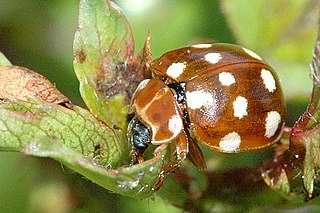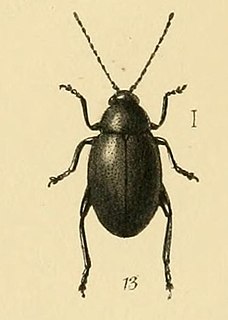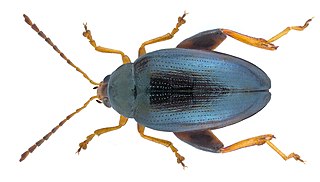
Cetonia aurata, called the rose chafer or the green rose chafer, is a beetle, 20 millimetres long, that has a metallic structurally coloured green and a distinct V-shaped scutellum. The scutellum is the small V-shaped area between the wing cases; it may show several small, irregular, white lines and marks. The underside of the beetle has a coppery colour, and its upper side is sometimes bronze, copper, violet, blue/black, or grey.

The insects of the beetle family Chrysomelidae are commonly known as leaf beetles, and include over 37,000 species in more than 2,500 genera, making up one of the largest and most commonly encountered of all beetle families. Numerous subfamilies are recognized, but the precise taxonomy and systematics are likely to change with ongoing research.

Histeridae is a family of beetles commonly known as clown beetles or Hister beetles. This very diverse group of beetles contains 3,900 species found worldwide. They can be easily identified by their shortened elytra that leaves two of the seven tergites exposed, and their geniculate (elbowed) antennae with clubbed ends. These predatory feeders are most active at night and will fake death if they feel threatened. This family of beetles will occupy almost any kind of niche throughout the world. Hister beetles have proved useful during forensic investigations to help in time of death estimation. Also, certain species are used in the control of livestock pests that infest dung and to control houseflies. Because they are predacious and will even eat other Hister beetles, they must be isolated when collected.

The noble chafer is a species of beetles belonging to the family Scarabaeidae, subfamily Cetoniinae.

The flea beetle is a small, jumping beetle of the leaf beetle family (Chrysomelidae), that makes up the tribe Alticini which is part of the subfamily Galerucinae. Historically the flea beetles were classified as their own subfamily.

Cleridae are a family of beetles of the superfamily Cleroidea. They are commonly known as checkered beetles. The family Cleridae has a worldwide distribution, and a variety of habitats and feeding preferences.

The cat flea is an extremely common parasitic insect whose principal host is the domestic cat, although a high proportion of the fleas found on dogs also belong to this species. This is despite the widespread existence of a separate and well-established "dog" flea, Ctenocephalides canis. Cat fleas originated in Africa but can now be found globally. As humans began domesticating cats, the prevalence of the cat flea increased and spread throughout the world.

Macrodactylus subspinosus is a North American beetle of the family Scarabaeidae. The members of this genus are known as "rose chafers", not to be confused with the European "rose chafer", Cetonia aurata. M. subspinosus occurs from Eastern Canada to Colorado and is considered a pest of many crops and flowers. It is given its common name of rose chafer because it eats the leaves of roses, although it also feeds on many other plants.

Bythotrephes longimanus, or the spiny water flea, is a planktonic crustacean less than 15 millimetres (0.6 in) long. It is native to fresh waters of Northern Europe and Asia, but has been accidentally introduced and widely distributed in the Great Lakes area of North America since the 1980s. Bythotrephes is typified by a long abdominal spine with several barbs which protect it from predators.

The European rhinoceros beetle is a large flying beetle belonging to the subfamily Dynastinae.

Acleris variegana, the garden rose tortricid moth or fruit tortricid, is a moth of the family Tortricidae. It has a Palearctic distribution. The moth flies from July to September mainly at night and is attracted to bright lights. The larvae feed on various trees and shrubs including rose and apple.

Calvia quatuordecimguttata, the cream-spot ladybird, is a species of ladybird in the family Coccinellidae. Its distribution is holarctic, it being found in Europe and through the East Palearctic to Japan. It is introduced to North America. This ladybird is generally 4 to 5 millimetres in length and varies in appearance depending on the geographical location. It usually lives in hedgerows and deciduous trees.

Necrobia rufipes, the red-legged ham beetle, is a species of predatory beetle, in the family Cleridae, with a cosmopolitan distribution, first described by Charles De Geer in 1775.

Chrysomela populi is a species of broad-shouldered leaf beetle belonging to the family Chrysomelidae, subfamily Chrysomelinae.

Crepidodera is a genus of flea beetles in the family Chrysomelidae. There some 40 described species worldwide.
Adelphocoris lineolatus, common names for which are rapid plant bug or superb plant bug, is a species of Hemiptera in the family Miridae, that can be found everywhere in the United States, and in the Peace–Athabasca Delta, Canada. The species are larger than other members of the family, and are either yellowish-black or orange-black coloured.

Stenocorus meridianus is a species of longhorn beetle in the Lepturinae subfamily that can be found anywhere in Europe, Caucasus, and Kazakhstan. They are 15–27 millimetres (0.59–1.06 in). The species have brown coloured legs, but can have either black (female) or brown (male) coloured prothorax. They occasionally feed on deciduous trees such as elm, maple, and oak. The species life cycle is from 2–3 years, with a flight time from May–July.

Longitarsus nigerrimus is a greenish-black coloured species of beetle in the subfamily Alticinae that can be found in European countries such Austria, Czech Republic, France, Germany, Great Britain, Hungary, Italy, Poland, Slovenia, Switzerland, Benelux, Yugoslavian states, Baltic states, Scandinavia, and in Eastern Europe. It can also be found in North Russia, specifically in Siberia and east to Amur.

Brachinus crepitans is a species of ground beetle in the Brachininae subfamily that can be found in Europe, central Asia, the Middle East, and northern Africa.

Psylliodes chrysocephala or Psylliodes chrysocephalus, commonly known as the cabbage-stem flea beetle, is a species of leaf beetle situated in the subfamily Galerucinae and the tribe Alticini.



















